

Partner Herbert Machiz
Queer Places:
Ulbrich's Bookstore, 395 Main St, Buffalo, NY 14203
Upstate Office, 639 Main St, Buffalo, NY 14203
201 E 38th St, New York, NY 10016
(with Waldemar Hansen)
View Office, 1 E 53rd St, New York, NY 10022
E 9th St & 1st Avenue, New York, NY 10009
Tibor de Nagy Gallery, 219 East 53rd Street
37 W 56th St, New York, NY 10019
Tibor
de Nagy Gallery, 24 E 67th St, New York, NY 10065
John Bernard Myers Gallery, 50 West 57th
Street
59 E 79th St, New York, NY 10075
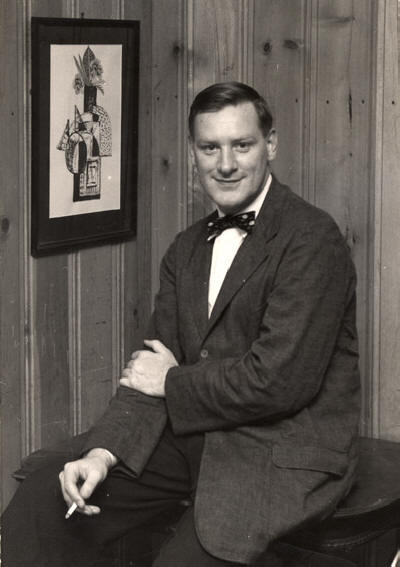 John Bernard Myers
(1920 - July 26, 1987) was an art dealer and writer who presented and
published the work of many well-known New York artists and poets. He was born
in Buffalo, New York, and moved to New York City in 1944 to become managing
editor of View magazine. After View ceased publication, Myers opened the Tibor
de Nagy Gallery in 1950 in partnership with
Tibor de Nagy, with Myers
serving as gallery director. The gallery was home to many artists of the New
York School, and published books of poetry and prints, as well as literary
magazines. Myers wrote many articles of criticism as well as a book on the New
York School poets. He and de Nagy dissolved their partnership in 1970.
John Bernard Myers
(1920 - July 26, 1987) was an art dealer and writer who presented and
published the work of many well-known New York artists and poets. He was born
in Buffalo, New York, and moved to New York City in 1944 to become managing
editor of View magazine. After View ceased publication, Myers opened the Tibor
de Nagy Gallery in 1950 in partnership with
Tibor de Nagy, with Myers
serving as gallery director. The gallery was home to many artists of the New
York School, and published books of poetry and prints, as well as literary
magazines. Myers wrote many articles of criticism as well as a book on the New
York School poets. He and de Nagy dissolved their partnership in 1970.
A colorful and disputatious presence in the art world for more than 40 years, Myers - as a partner in the Tibor de Nagy Gallery from 1951 to 1970 - mounted the first solo shows of such New York painters as Larry Rivers, Grace Hartigan, Helen Frankenthaler, Red Grooms, Alfred Leslie and Fairfield Porter.
He also promoted and published the work of a number of budding writers whom he called ''Poets of the New York School'' - including John Ashbery, Barbara Guest, James Schuyler, Kenneth Koch and Frank O'Hara. With his longtime companion, stage director Herbert Machiz, he was involved from 1953 to 1969 with the Artists Theater, which produced new or little-known works by playwrights and poets with sets designed by New York artists.
Strongly opinionated about art and literature, and a firm believer in the talents he espoused, Myers was never one to mince words in dealing with those who did not share his enthusiasms. Yet even the recipients of his tongue-lashings agreed that they were wittily delivered, and he enlivened many art parties with his gifts for anecdote, mimicry, singing and cooking.
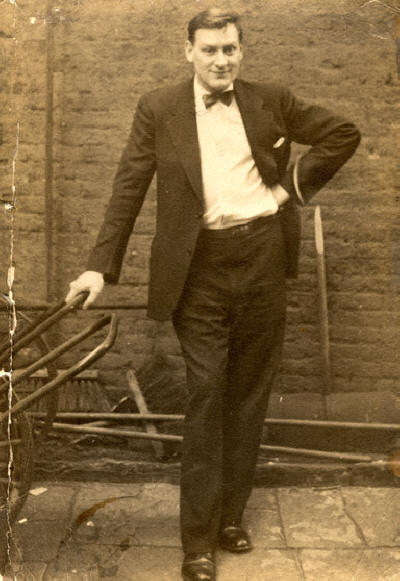
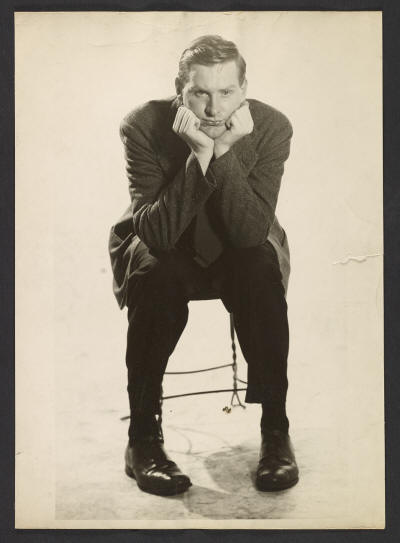
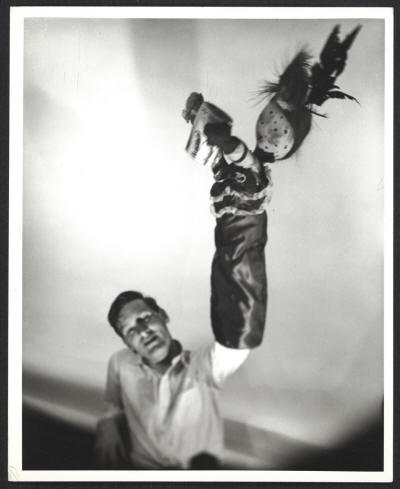
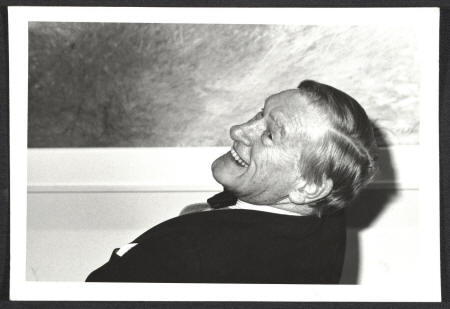
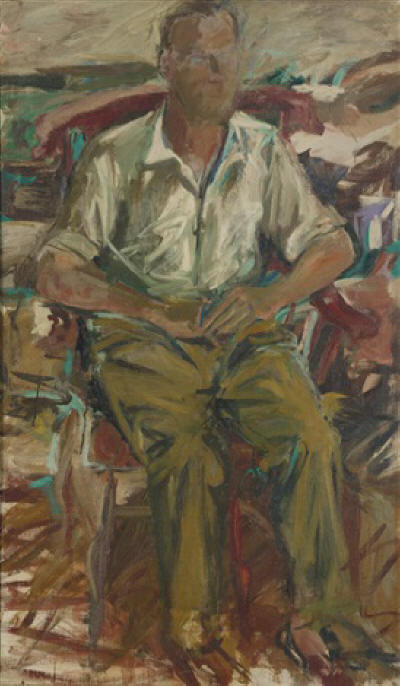
by Elaine de Kooning
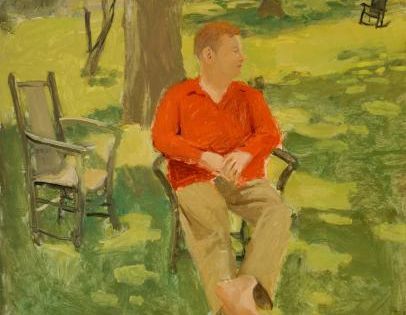
by Fairfield Porter
John Bernard Myers, who was born in Buffalo, established his own puppet theater there as a teen-ager, during the French class at Lafayette High School. During his youth in Buffalo, New York, John Bernard Myers developed life-long interests in poetry, puppets, and painting. As a teenager, he wrote poetry and established his own marionette theater. He first learned about modern art and became especially interested in Surrealism through reading European magazines and exhibition catalogs in the library of the Albright-Knox Art Gallery. Through helping to edit Upstate, an avant garde literary magazine, he met many like-minded friends. Myers was deemed unqualified for military service due to ruptured eardrums, so instead went to work in an airplane factory. But his membership in the Young Communist League and participation in efforts led by a Socialist Workers party colleague to upgrade job assignments and pay for qualified minorities created problems and Myers soon departed. His final two years in Buffalo were spent working in a bookstore.
In school, Myers was friend with Irving Janis, whose uncle Sidney Janis, was an art collector and critic in New York City. Sidney Janis used to date Myers' older sister, Evelyn. During this time he was also friend with Edward Maisel, who would later publish a biography of the composer Charles Tomlinson Griffes, and was later to marry Betty Cage, who knew both Myers and Maisel from Buffalo and lived downstairs Myers in New York and worked for View, edited by Parker Tyler and Charles Henri Ford, as well (a job Myers found for her). She was later an administrator of the New York City Ballet, for Lincoln Kirstein.
Myers was rejected by both the Army and Navy in WWII because of ruptured eardrums. He went to work in a airplane plant, but he left when, with his friend Dave Weinstein, both members of the Socialist Workers party, brought to the attention of the union that African-American employees in the plant had been getting the worst jobs, for which they received the lowest pay. Myers went to work at Ulbrich's bookstore, in charge of Poetry and Belles Lettres, Biography and Essays. He became friend with Otto Grauer, Jr, the manager of the book department and son of the founder, Otto Grauer, Sr.
He also helped edit a literary magazine, Upstate, and his success with it brought him a job in New York as managing editor of View, an avant-garde quarterly edited by the film critic Parker Tyler and the writer Charles Henri Ford. In 1944, Myers sent issues of Upstate to Parker Tyler, editor of View, whom he had met a few years earlier through mutual friends, Nancy and Philip Haydock, involved with the Communist party. A few months later Tyler offered him the position of managing editor of View, a magazine devoted to the Neo-Romantics and Surrealists in exile.
Myers moved to New York City and remained with the magazine until it ceased publication in 1947. At first he shared an apartment with Waldemar Hansen. A large portion of his time at View was spent selling advertising space. Since this involved calling on gallery owners each month, he came to know many dealers, had the opportunity to study the exhibitions and meet many of the artists. During this period he began attending art history courses taught by Meyer Schapiro at the New School. His responsibilities at View also included assisting with editing and layout, and he became well-acquainted with Marcel Duchamp and André Breton when special issues devoted to them were published. His association with the magazine resulted in many invitations; Myers enthusiastically attended parties practically every night of the week, enlarging his already impressive circle of friends and acquaintance in the art and literary worlds.
For more than thirty years after View ceased publication, a number of art and poetry publications benefitted from Myers' editorial skills. Among them were Prospero Pamphlets, a series of chapbooks produced between 1946 and 1948, featuring contemporary poets Wallace Stevens, Charles Henri Ford, Parker Tyler, and Paul Goodman. Brunidor Editions, a portfolio of graphics by Yves Tanguy, Joan Miró, Kurt Seligmann, Max Ernst, Wilfredo Lam, Matta, and Stanley William Hayter was issued in 1948.
In Manhattan, he continued to stage marionette shows, and he attended the famous classes in art history conducted by Meyer Schapiro at the New School. He quickly became acquainted with the cognoscenti of the art and literary worlds. Puppets were another of Myers' special interests.
In the summer of 1946, John Bernard Myers performed a puppet show at Spivy’s Roof in New York. He asked Charles Henri Ford to write a puppet play for him, and Ford then suggested he also ask Jane Bowles for a sketch and Paul Bowles to write some music for both. Myers was friendly with Kurt Seligmann, who made the puppets. Ford’s sketch for three characters was called A Sentimental Playlet and involved a clown, a sailor and a wild-haired lady. Bowles’ play was called A Quarreling Pair and had two sisters who lived in separate rooms, one room very messy and the other room very neat. John Latouche came to Myers after the performance, full of effusive congratulations, and shortly after that Myers was taken to Mary McCarthy’s table; she said she had enjoyed the show. When Myers went out to the terrace for some fresh air, a friend beckoned him to a table, where he met Ned Rorem and his companion Maggie von Maggerstadt. Rorem said he too would like to compose some songs for puppets if Myers ever did another show.
After View ceased publication in 1947, he edited poetry and art publications, but to earn his living he resumed puppeteering. Around 1948 Myers met Tibor de Nagy, a cultured Hungarian immigrant with a background in banking and finance, who, for immigration purposes, needed a business that bore his name. The Tibor de Nagy Marionette Company gave performances at schools in and around New York City and staged elaborate productions for both children and adults at fine hotels. After several years of physically exhausting work with the marionette company and falling profits, the two decided to try another business venture.
At the end of 1947, Hansen left New York for London to live with Peter Watson. Myers found a new friend, the ambitious playwright Randolph Carter, who was willing to share expenses.
In 1949 John Bernard Myers and Tibor de Nagy organized a production company specialied in puppet shows. The first production they launched was a Pueblo Indian fairy tale inspired by Max Ernst's enchanting collection of Kachina dolls. Their collaborators were Bernard Pfriem, who designed the production; the playwright Randolph Carter, who wrote much of the dialogue; the poet Charles Boultenhouse, who wrote three lyrics; and Ned Rorem, who set the lyrics to music for voice and tympani. The hour-long play was entitled Fire Boy.
In 1949 John Bernard Myers moved to E 9th St & 1st Avenue. It was a two-bedroom apartment with a garden and a decent-sized living room. The are was new to him, but he soon discovered he had friends in the neighborhood. He began to attend meetings regularly at The Club and to go to the Cedar Bar.
After View folded, Myers organized - with a partner, Tibor de Nagy - the Tibor de Nagy Gallery, and served as its director for 19 years. The gallery was stubbornly eclectic. Myers was never swayed by trends, and showed a wide range of talents, from the abstract motifs of Robert Goodnough to the droll figures of Red Grooms. Over the years, several of Myers' friends and acquaintances had suggested he open an art gallery. Myers was interested and had many appropriate contacts, but lacked sufficient capital and had no business experience. An old friend, Dwight Ripley, offered to back a gallery and in 1951 the Tibor de Nagy Gallery opened at 219 East 53rd Street with John Bernard Myers as the gallery director. Tibor de Nagy was the gallery's business manager, and at the same time pursued a full-time career in banking. Following the good advice of his friends Jackson Pollock, Lee Krasner, and Clement Greenberg, Myers decided to seek out and promote the artists of his own generation. Artists affiliated with the Tibor de Nagy Gallery included Helen Frankenthaler, Robert Goodnough, Red Grooms, Grace Hartigan, Alfred Leslie, Barnett Newman, Kenneth Noland, Fairfield Porter, and Larry Rivers.
In 1952 John Bernard Myers was invited to a big party in the town house of Jack and Grace Borgenicht, the art dealer who became prominent a few years later. At this party he met the person with whom he would be living for the next 25 years, Herbert Machiz. He took him about three months to realize that Herbert was one of the most remarkable human beings he had ever met. Myers moved with Machiz to West 56th Street.
In 1953 Tibor de Nagy Gallery moved to 24 East 67th St. From 1953 until 1956, Tibor de Nagy Gallery published Semi-Colon, a poets' newsletter edited by Myers. Gallery Editions, a series of pamphlets paired the work of a poet and painter, among them: John Ashbery and Jane Freilicher, Frank O'Hara and Larry Rivers, Kenneth Koch and Nell Blaine, and Barbara Guest and Robert Goodnough.
In 1956 John Bernard Myers was a guest for a few days at Reddish House. Cecil Beaton's mother, although of great age, was still vigorous enough to do a little gardening and to enjoy the pugs that scampered underfoot. Beaton had a glass room with a small pool in the center of a wide variety of potted plants on shelves; there they would have tea. Mrs Beaton was particularly proud of the tuberoses. Tall, daughty, very proper, the old lady, when Beaton told her he was considering marriage to Greta Garbo, looked at him sternly and asked, "Pray, who may that be?", and became quite frigid when he explained she was an actress.
In 1970, Myers set up shop under his own name, John Bernard Myers Gallery at 50 West 57th Street, but four years later, concerned over the increasing financial burdens of running a gallery, he retired. Myers and de Nagy remained partners in the Tibor de Nagy Gallery for 19 years. In 1970 Myers left in to open a gallery which he ran for about five years under his own name.
In 1972 Cecil Beaton designed for the ballet Illuminations. He asked to John Bernard Myers to make suggestions and he suggested Beaton look at the work of Paul Klee for an image to suggest a dour sky and crazy-looking church suitable for the painted backdrop. Just before the opening, at a dress rehearsal, Beaton and the choreographer Frederick Ashton got into a screaming squarrel about Karinska's dressmaking. Beaton was devoted to Karinska. Somebody asked Lincoln Kirstein what the ruckus was downstairs, and Lincoln replied, "Oh, Cecil and Freddie are once again at needlepoints..." The two of them were the best of friends, but temperamental when it came to production time.
Since 1970, Myers divided his time between work as a private dealer, lecturer, publisher (of an art-and-literary quarterly, Parenthese), writer and exhibition organizer. In 1981 he organized a show of his favorite contemporary artists, called ''Tracking the Marvelous,'' for the Grey Art Gallery at New York University. After retiring from the gallery, he was a private dealer and lecturer; he also served as a consultant to the Kouros Gallery. He continued to organize exhibitions including a Joseph Cornell exhibiton at A.C.A. Gallery in 1977, and "Tracking the Marvelous" at the Grey Gallery, New York University in 1981. Myers devoted a great deal of time to Parenthése, a magazine of words and pictures, that was published between 1975 and 1979. In addition, he compiled and edited Poets of the New York School, an anthology with photographs by Francesco Scuvullo published by the University of Pennsylvania Art Department in 1968.
He gave the same title of his exhibition, ''Tracking the Marvelous,'' two years later to a book that described his adventures in the art world. His use of the word ''marvelous,'' Myers explained, derived from the ''Surrealist Manifesto'' by Andre Breton, a poet he much admired. ''I could think of no more prodigious word and no greater goal in life than to seek for the marvelous,'' he said. For much of his life, John Bernard Myers kept a diary recording daily activities and his reactions to an reflections on his experiences. His autobiography, Tracking the Marvelous: A Life in the New York Art World, published in 1984, quotes extensively from diaries written as early as 1939. He wrote many book reviews, exhibition reviews, and articles about art and art criticism that were published in Art in America, Arts, Artforum, Art and Literature, Art International, Art News, Art/World, Craft Horizons, and Smithsonian. Knowing What I Like, a selection of his own essays and articles that Myers compiled and edited in 1983, remains unpublished. He also wrote poetry and song lyrics.
He died of cancer of the bladder on July 26, 1987, at the Danbury (Conn.) Hospital. He was 67 years old and lived in Manhattan.
My published books: